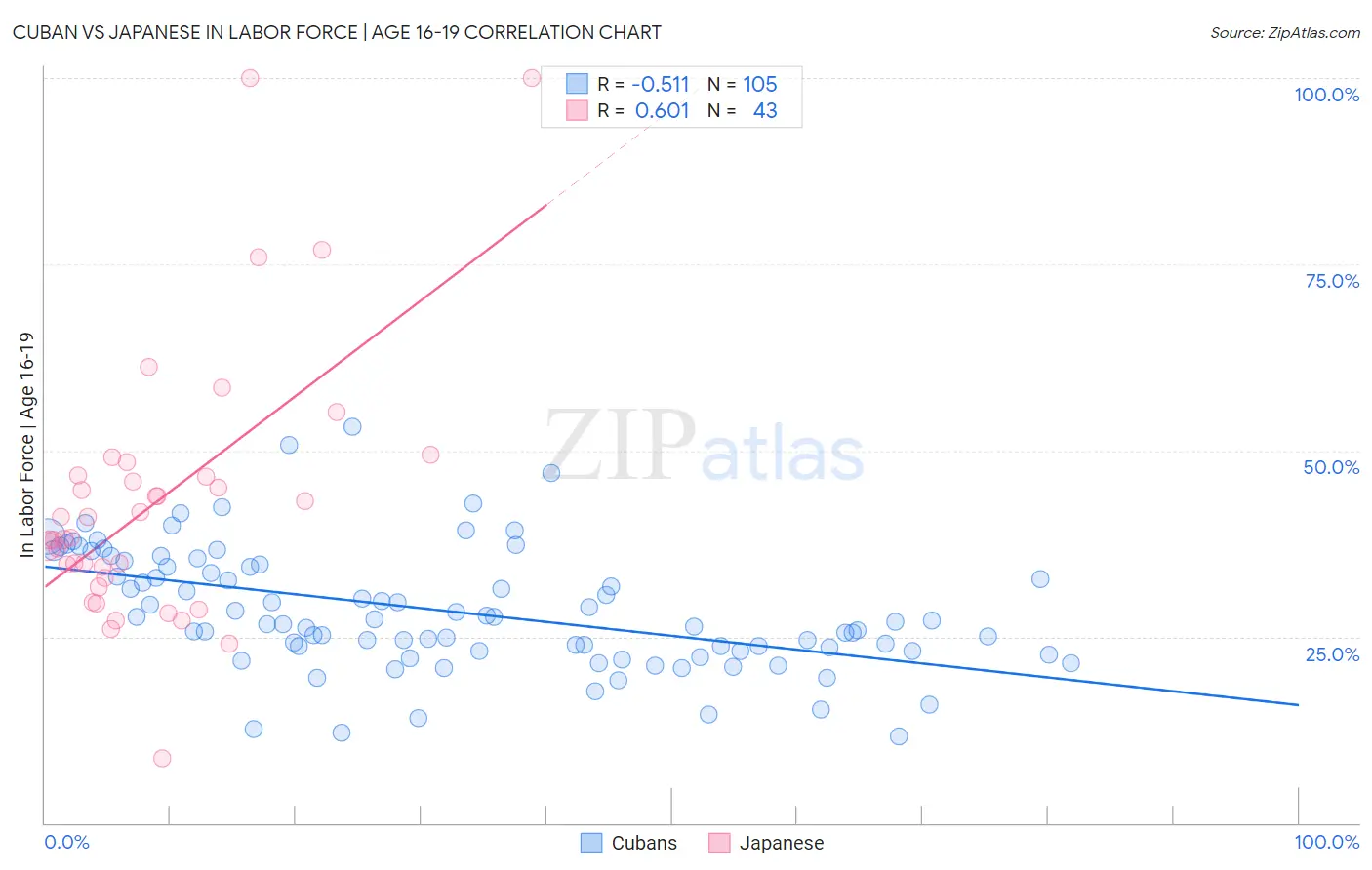Cuban vs Japanese In Labor Force | Age 16-19
COMPARE
Cuban
Japanese
In Labor Force | Age 16-19
In Labor Force | Age 16-19 Comparison
Cubans
Japanese
31.8%
IN LABOR FORCE | AGE 16-19
0.0/ 100
METRIC RATING
314th/ 347
METRIC RANK
37.5%
IN LABOR FORCE | AGE 16-19
89.3/ 100
METRIC RATING
144th/ 347
METRIC RANK
Cuban vs Japanese In Labor Force | Age 16-19 Correlation Chart
The statistical analysis conducted on geographies consisting of 448,345,654 people shows a substantial negative correlation between the proportion of Cubans and labor force participation rate among population between the ages 16 and 19 in the United States with a correlation coefficient (R) of -0.511 and weighted average of 31.8%. Similarly, the statistical analysis conducted on geographies consisting of 249,091,187 people shows a significant positive correlation between the proportion of Japanese and labor force participation rate among population between the ages 16 and 19 in the United States with a correlation coefficient (R) of 0.601 and weighted average of 37.5%, a difference of 18.2%.

In Labor Force | Age 16-19 Correlation Summary
| Measurement | Cuban | Japanese |
| Minimum | 11.7% | 8.6% |
| Maximum | 53.2% | 100.0% |
| Range | 41.5% | 91.4% |
| Mean | 28.5% | 43.1% |
| Median | 27.0% | 38.2% |
| Interquartile 25% (IQ1) | 23.0% | 32.8% |
| Interquartile 75% (IQ3) | 34.6% | 46.7% |
| Interquartile Range (IQR) | 11.6% | 13.8% |
| Standard Deviation (Sample) | 8.1% | 17.9% |
| Standard Deviation (Population) | 8.1% | 17.7% |
Similar Demographics by In Labor Force | Age 16-19
Demographics Similar to Cubans by In Labor Force | Age 16-19
In terms of in labor force | age 16-19, the demographic groups most similar to Cubans are Immigrants from Belize (31.8%, a difference of 0.16%), Hopi (31.8%, a difference of 0.16%), Immigrants from West Indies (31.7%, a difference of 0.18%), Filipino (31.7%, a difference of 0.26%), and Indian (Asian) (31.9%, a difference of 0.31%).
| Demographics | Rating | Rank | In Labor Force | Age 16-19 |
| Immigrants | Jamaica | 0.0 /100 | #307 | Tragic 32.2% |
| Navajo | 0.0 /100 | #308 | Tragic 32.1% |
| Immigrants | Eastern Asia | 0.0 /100 | #309 | Tragic 32.0% |
| Immigrants | Iran | 0.0 /100 | #310 | Tragic 32.0% |
| Indians (Asian) | 0.0 /100 | #311 | Tragic 31.9% |
| Immigrants | Belize | 0.0 /100 | #312 | Tragic 31.8% |
| Hopi | 0.0 /100 | #313 | Tragic 31.8% |
| Cubans | 0.0 /100 | #314 | Tragic 31.8% |
| Immigrants | West Indies | 0.0 /100 | #315 | Tragic 31.7% |
| Filipinos | 0.0 /100 | #316 | Tragic 31.7% |
| Immigrants | Nicaragua | 0.0 /100 | #317 | Tragic 31.6% |
| Immigrants | Yemen | 0.0 /100 | #318 | Tragic 31.5% |
| Soviet Union | 0.0 /100 | #319 | Tragic 31.4% |
| Ecuadorians | 0.0 /100 | #320 | Tragic 31.4% |
| West Indians | 0.0 /100 | #321 | Tragic 31.3% |
Demographics Similar to Japanese by In Labor Force | Age 16-19
In terms of in labor force | age 16-19, the demographic groups most similar to Japanese are Paiute (37.5%, a difference of 0.0%), Pakistani (37.6%, a difference of 0.020%), Sierra Leonean (37.6%, a difference of 0.050%), Immigrants from Western Europe (37.5%, a difference of 0.050%), and Brazilian (37.5%, a difference of 0.080%).
| Demographics | Rating | Rank | In Labor Force | Age 16-19 |
| Cajuns | 93.2 /100 | #137 | Exceptional 37.8% |
| Comanche | 91.9 /100 | #138 | Exceptional 37.7% |
| Immigrants | Moldova | 91.9 /100 | #139 | Exceptional 37.7% |
| Estonians | 91.7 /100 | #140 | Exceptional 37.7% |
| Syrians | 90.7 /100 | #141 | Exceptional 37.6% |
| Sierra Leoneans | 89.7 /100 | #142 | Excellent 37.6% |
| Pakistanis | 89.5 /100 | #143 | Excellent 37.6% |
| Japanese | 89.3 /100 | #144 | Excellent 37.5% |
| Paiute | 89.3 /100 | #145 | Excellent 37.5% |
| Immigrants | Western Europe | 88.9 /100 | #146 | Excellent 37.5% |
| Brazilians | 88.7 /100 | #147 | Excellent 37.5% |
| Romanians | 87.3 /100 | #148 | Excellent 37.5% |
| Native Hawaiians | 85.0 /100 | #149 | Excellent 37.4% |
| Tsimshian | 84.7 /100 | #150 | Excellent 37.4% |
| Immigrants | Poland | 84.4 /100 | #151 | Excellent 37.3% |